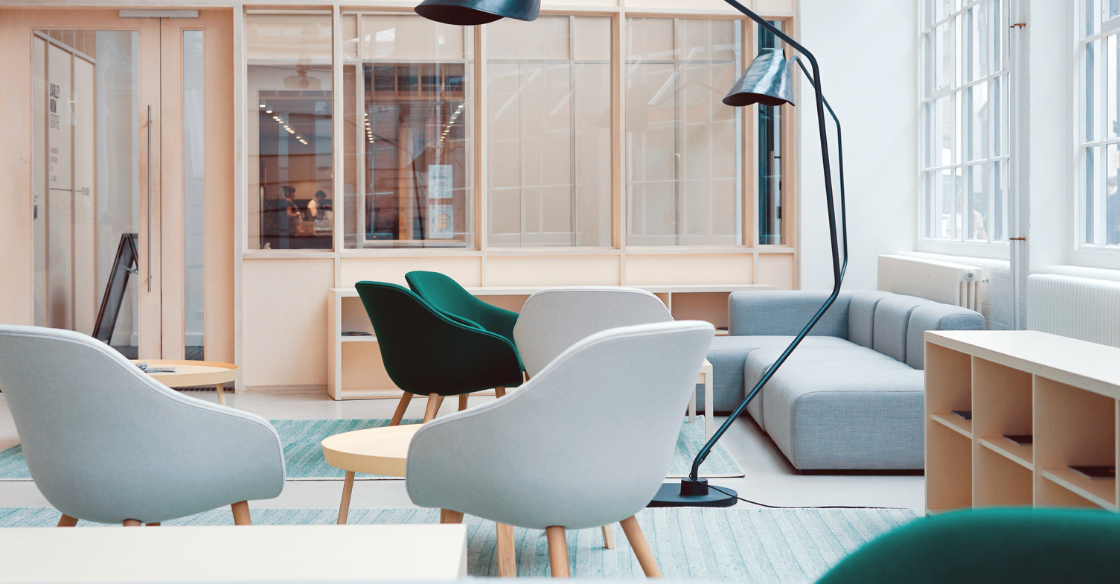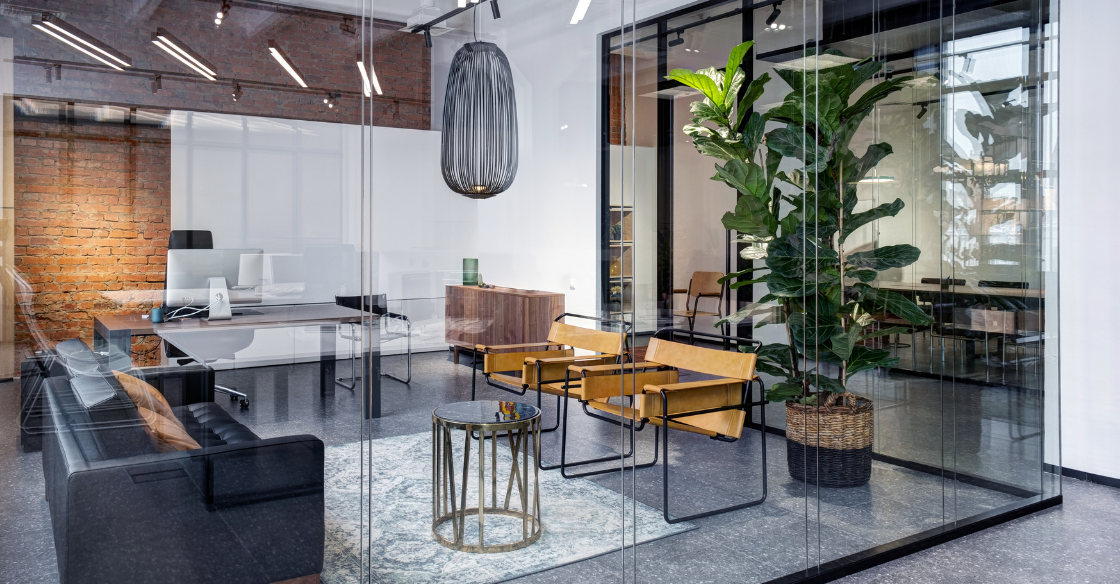If you thought that being productive was difficult before COVID-19 turned the world upside down, the post-pandemic workplace presents a whole new set of challenges (and opportunities).
With 74% of businesses bringing their staff back to work and that figure expected to rise, there are bound to be some adjustments. Flexible scheduling, reduced capacity, and remote work are fast becoming embedded into the new workplace culture.
As more offices continue to invite employees back to the physical office, they can help ease the transition by creating an environment that inspires creativity and collaboration while promoting safety and privacy.
In this guide, we’ll share our top productivity hacks for both the individual worker as well as executives who want an office design that facilitates getting things done.

Office Productivity Hacks for the Individual
Studies have shown that remote workers tend to put in more hours and are more productive than on-site staffers. Still, working from home can have its challenges. Family members, daytime television, household chores, and the lure of a nap can all derail productivity, and that might give employers pause about letting employees work from home indefinitely.
Further, the majority of companies in a PricewaterhouseCoopers poll have expressed the desire to have employees return to work at least three days a week to maintain company culture. While executives want their team members back in place, employees are more reluctant to return to the office.
What’s most likely to occur and we see in these reports is the evolution of a hybrid workplace. This means that most companies won’t have every employee in the office at the same time. Instead, an office might be at half capacity with everyone on-site only for special events like town hall meetings, hands-on projects, or brainstorming sessions that benefit from a physical presence.
If you find yourself in an environment where you’re only in the office part-time, and you don’t always have physical access to your coworkers, here are five ways you can maximize your productivity.

Tip 1: Plan tasks according to your environment
Dividing your time between remote and in-office work means that some tasks are better suited for home, while others might be done more efficiently in the company of your colleagues.
For example, if you need to concentrate and do deep work, you could plan those time blocks for when you’re in a quiet home office. Planning sessions that require the participation of your coworkers might benefit from being done in the office where you can dialog face-to-face and have everyone put input on a whiteboard.
As you adjust to a hybrid environment, you’ll naturally figure out how best to divide your time between your different workplace settings. Knowing where you do your best work and why will help you plan your schedule to be more productive.
Tip 2: Try time blocking
You might fancy yourself a multi-tasker, but the theory that we can get more done by multitasking is a long-debunked myth.
If you really want to know how to be productive, the trick is focusing on one thing at a time. When a task gets your full attention, you can concentrate and work more quickly.
Time blocking involves dividing your day into distinct chunks of time. Each time block is dedicated to only one task. It might be something on your to-do list, or it can involve strategic planning.
The time you block for each job can also vary. You could start with 60 or 90-minute time blocks followed by a 10-minute break. The trick is to concentrate long enough to be productive but not spend so much time on one thing that you end up wasting valuable hours.
Another benefit of time blocking is that it takes the guesswork out of your day. Instead of being overwhelmed by a long mental to-do list, you’ll have your plan laid out on paper (or in a digital calendar).
Tip 3: Achieve Inbox Zero
Is your inbox cluttered with junk? Do you have hundreds (or thousands) of messages taking up space in your inbox? With more correspondence taking place between remote workers, emails can tend to pile up.
Achieving Inbox Zero is one of the most satisfying experiences you can have in the workplace. It involves moving every single email out of your inbox. File them according to topic, project, or person and file them into distinct folders if you’ll need to access them later.
For general correspondence or task assignments, aim to address each message daily or at least weekly.
One of the best ways to keep your inbox clear is to send fewer emails. Thanks to communication tools like Slack, you can easily have a dialogue via chat that doesn’t require an endless email thread.

Tip 4: Make sure you have the right tools
Is your laptop on its last legs? Are you missing a valuable piece of software that will make your job much easier?
Though it can be challenging for a cash-strapped company to shell out the cash needed for additional assets, it costs more to the company if you’re not able to do your job efficiently.
If anything holding you back can be solved by adding a tool, make a note of the obstacle, what device can solve it, how much it costs, and how much time it will save you. You’ll be more likely to get what you want if you can show your employer that the right tools will save company resources.
Tip 5: Make time for social interactions
Adjusting from a 30-second commute from your bed to your home office involves more than just showering daily and navigating road traffic. You might also have to relearn how to socialize with coworkers face-to-face.
Socializing with your coworkers can break up the monotony of your day, but don’t fall into the trap of mistaking idle conversation with productivity.
We recommend being conscious of how much time you’re spending socializing, but that doesn’t mean you should view conversations with your coworkers as a waste of time. This collaboration can help you solve problems and think through various solutions. It can also help you reset your brain if you’re stuck on a task.
A social coffee break in the late morning or a lunchtime walk with someone in your department is another great way to decompress while also forming a bond with the people you share an office with.

How to Transform an Office for Optimal Productivity
The right environment can also help with office productivity. An office redesign that includes natural light, a new color palette, plants, and ergonomic features can go a long way to increasing productivity and creating a space where people actually want to work.
A redesigned office floor plan to increase productivity can also make a major difference in morale and your bottom line.
After redesigning hundreds of offices, we’ve compiled five tips that modernize your office and give your productivity a boost.
These tips center around using Cover Glass’s proprietary system of interior frameless glass doors and walls to create a flexible office floor plan that adapts to different work styles.

Tip 1: Create an open office feel with distinct barriers
Companies are quickly moving away from closed-off offices and moving toward open floor plans. While some businesses believe that this structure (or lack thereof) encourages collaboration and saves on square footage, many workers feel that this environment is distracting.
As workers transition from home offices back to a corporate environment, it can be helpful for office productivity and work habits to find a happy medium. One way is to create glass barriers between work areas. This arrangement allows workers to see the office floor and feel like they’re a part of the group, but the glass can muffle sound and create an official barrier between workspaces.

Tip 2: Create flexible spaces
One of the biggest advantages of frameless glass sliding doors is that they allow you to rearrange space as needed. When you want to close off an area, simply fold or close the doors. If you want a more collaborative environment, all you have to do is open them, and voila!
Tip 3: Designate communal areas for collaboration
Two heads can be better than one, and if your team needs a space to collaborate, they can use a flexible space or meeting room that’s a part of the office and separated by a glass wall. This arrangement offers transparency while also specifying an area that’s distinct from individual workspaces.

Tip 4: Construct modern meeting rooms
A conference room surrounded by opaque walls can feel suffocating. If it does happen to have a window, that single glimpse into the outside world can be captivating and a distraction.
By contrast, a glass-walled meeting room creates an open feel with plenty of natural light. You could even use partitions that allow you to adjust the size of the room depending on how many attendees are present or add shades when you want privacy.

Tip 5: Create as many offices as you need
If you do have a giant open space, the idea of outfitting the building with walls to create offices can be a daunting and prohibitively expensive task. An alternative is to construct offices using frameless glass for the walls.
Are You Ready to Redesign Your Office for Maximum Productivity?
If the pandemic taught us anything, it’s that we have to be flexible and able to adapt to a rapidly changing world. By adopting a system of Cover Glass frameless glass walls in your office space, you can easily change your layout. Plus, your office will look and feel modern and inviting!
Want more inspiration on how to be productive? Check out our post on home office design solutions that apply to remote and on-site environments. Ready to discuss the next steps? Contact us to request a quote.
◊◊◊
Experience the difference. Choose Frameless. Choose Cover Glass USA.


